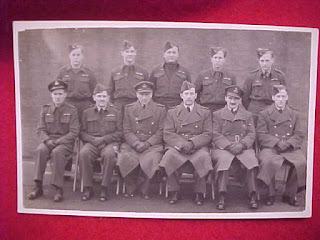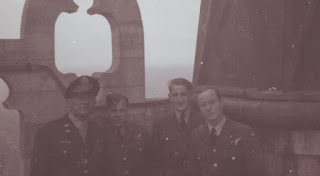In 2012 I was delighted to help film director Manfred Becker with his fascinating documentary on the 1942 RCAF Hurricanes Greys Cup winning team, featuring No.69 Robert Sarvis! Here's a little bit about the programme and this famous football team in which Bob Sarvis played an integral part.
Beacher’s photograph inspires Grey Cup doc

This
photo of the 1942 RCAF Hurricanes – winners of a wartime
Grey Cup
– includes Jake Gaudaur in the back row (drinking a Coke); Ed Poscavage
is near Jake's right elbow, just peeking out; coach Lew Hayman is in
uniform in the front row below Jake. The Photograph is one of several
episodes in a documentary series celebrating the history of the Grey
Cup, which celebrates its 100th anniversary this year.
Following the win the Hurricanes assembled in uniform for the obligatory victory photograph, and Gaudaur can be seen smiling and celebrating with his teammates. That photograph became one of the most prized possessions of the man who went on to become the Commissioner of The Canadian Football League (CFL) from 1968 through 1984, mostly because seven of Gaudaur's teammates from the Hurricanes – including his best friend Ed Poscavage – were killed fighting overseas within the two years following the big game.
Gaudaur's daughter, Jackie, remembers that tattered 70-year-old photograph and always wondered about the story behind it. Her voyage of discovery is part of an upcoming TSN-BellMedia special documentary called Engraved On A Nation, which celebrates the 100th anniversary of the Grey Cup. In this particular episode, called The Photograph, Jackie is accompanied by documentary filmmaker Manfred Becker to the former Uplands Air Force Base where her late father was stationed in the war.
“They took me up in a vintage Harvard training fighter, and flew me over the Gatineau region,” Gaudaur said. “It gave me the opportunity to see how vulnerable you are up there.”
Jackie also travelled with her sister Diane to Connecticut, for an emotional visit with the niece and nephew of Ed Poscavage.
“Ed was the best man at my father's wedding in 1943,” Jackie said. “He was shot down in March of 1945 just a few months before the war ended.”
Jackie took with her a framed drawing she had made of Poscavage in his helmet and jersey from the Hurricanes. “I was amazed to see how the impact of his death had spilled over into the next generation.”
While she sat in their living room, Poscavage's niece played an old phonograph record of an interview Ed had given to the BBC a few weeks before he was shot down. He spoke about his life back in Connecticut, some of the missions he had been on, and what he thought about Europe. He is heard to say, “I'm sure Paris will be much nicer after the war.” Ed was buried in France.
“I understood immediately why my father was such close friends with this man,” Jackie said. “He was charming, optimistic and articulate…very much like my father.”
Jackie said she is very excited about the Engraved On A Nation series, and, of course, this particular episode.
“I'm so pleased that this story is being told,” she said. “My father would have been so proud of this memorial for his teammates who didn't make it home.”
When The Photograph's director Manfred Becker, a Beach resident himself, was approached by the producer, Dugald Maudsley, to work on the project, he initially balked.
“You got the wrong guy,” Becker told him. “I've never seen a game of football in my life.”
Becker grew up in Germany, and had only ever seen the European football: soccer. But, he explained, the producers were looking for independent filmmakers – specifically not sports journalists – to bring a fresh approach to the series. Becker is the maker of another documentary, called Nazi In The Schoolyard, about his son's relationship with his grandfather – Becker's father – who served in the German army during the Second World War. The documentary focussed on the fact that many Germans involved in the war tended to bury the past and rarely spoke about it.
“What interested me about this story [The Photograph] is how memory can be forwarded from generation to generation,” he said. “The dead are never dead. They carry on in the living.”
He found it a very emotional experience to be at the meeting of the Gaudaur family and Poscavage’s relatives.
“Ed had become this mythical figure to them,” Becker said.
Listening to Poscavage's voice on the phonograph had, he said, an air of unworldliness to it. “The very reason that brought these two guys together – the war and that football team – ended up tearing them apart. It was a powerful reminder to me of why I make documentary films: to keep history alive – and fill it with meaning.”
The producer of The Photograph is Dugald Maudsley, whose company Infield Fly Productions is based in the Beach as well. Maudsley was also the producer of the show Ancestors in the Attic for The History Channel.
He also produced two of the other episodes in the series: The Crash of Flight 810, and The Anthony Calvillo Story. He recalled how he came to work on The Photograph.
“I knew that Jake Gaudaur was very prominent in the CFL,” he said. “Jake also had this photograph that meant a great deal to him, but no one really knew why. I eventually met Jackie and Diane and followed their search. The Photograph became such a symbolic story because there were so many similar instances during the War.”
As a producer, Maudsley's job was to help with the research, editing, and post-production of the episodes he was responsible for. He explained that things went very smoothly, and that he feels proud to be a part of the series.
“TSN is doing something fantastic in pursuing these stories that celebrate Canadian football,” he said.
This article was printed in The Beach Metro.





































